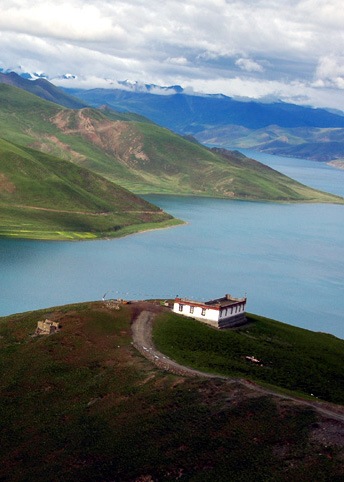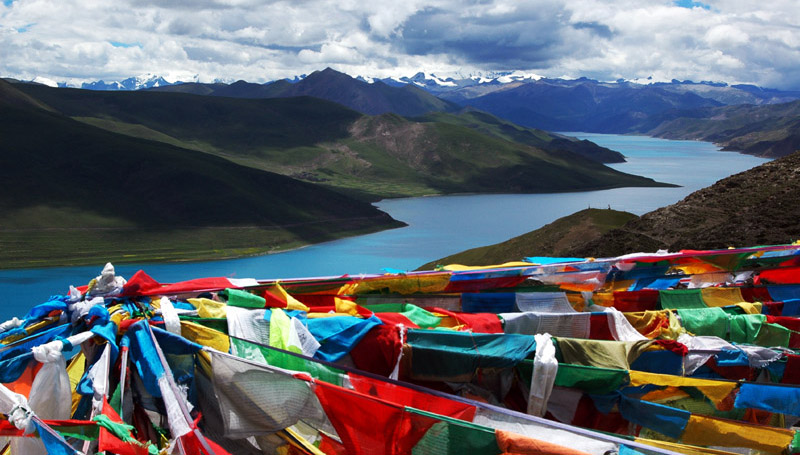
At the southern foot of the lofty Himalayan mount range lies Yamdrok Lake, one of the three holy lakes of Tibet, alongside Namtso Lake and Lake Manasarovar. Surrounded as it is by snowy climes, it appears like a deep blue sapphire embedded in a sea of pearls. This colossal freshwater lake was formed by melted snow trickling down from the nearby mountains. According to legend, Tibetans believe that the lake was once a goddess who transformed herself, and therefore it is a popular site for pilgrimage. Devout Buddhists will visit the lake, sometimes every year, to walk around its perimeter, an impressive feat which takes an average of 7 days! It is believed that, by performing this ritual, you wash away your sins and are more likely to experience good fortune in the future.
Yet the lake’s spiritual importance doesn’t end there. Yamdrok Lake has been used for decades to help Tibetans find the Dalai Lama. After a Dalai Lama passes away, the senior monks are left with the arduous task of finding the boy who harbours the reincarnated soul of the Dalai Lama and is therefore the next Dalai Lama. They gather on the banks of the lake to chant and pray before throwing a hada[1] and other sacred items into the lake. By peering into the water, they are supposedly offered a reflection of the specific location where the Dalai Lama’s soul currently resides. In short, Yamdrok Lake functions as a sort of holy GPS!
Situated 100 kilometres (62 mi) northeast of Lhasa and 90 kilometres (56 mi) west of a town named Gyantse, the lake’s remote location makes it tough to reach, but this is undoubtedly part of its bucolic charm. Its unusual shape, which gives it the appearance of a scorpion when viewed from above due to its two long “arms”, means it’s difficult to estimate its size, although the official surface area is listed at 638 square kilometres (246 sq. mi). Like gems scattered throughout its expanse, the lake is dotted with countless islands that serve as resting places for a myriad of bird species. During autumn and winter, thousands of birds migrate to the lake to nest, making it a veritable bird-watching hotspot.
Near to the lake’s edge, it is not uncommon to see locals tending to their yaks or walking their Tibetan mastiffs, animal species that have been integral to the development of Tibetan agriculture. Within the lake itself, a large population of freshwater fish has earned the lake the nickname “the treasure trove of Tibet”. Most Tibetans won’t eat the fish, as they believe they are the embodiment of their ancestors’ souls, but thriving fish farms on the lake regularly transport their goods to restaurants throughout Tibet. So you might want to avoid eating any fish dishes near to the lake, or risk accidentally dining on Great Aunt Gladys!

On a peninsula jutting into the lake, the Samding Monastery is the only Tibetan monastery to be headed by a woman. What makes this house of worship so unique is that it’s not a nunnery, meaning the female abbot presides over a community of male monks, as well as female nuns. This female abbot is known as the Samding Dorje Phagmo, who is considered to be the tulku[2] of the goddess Vajravārāhī. Not only is she considered to be the highest female incarnation in Tibetan Buddhism, she is also the third highest ranking person in the religion’s hierarchy after the Dalai Lama and the Panchen Lama.
About 7 kilometres (4 mi) west of the monastery, the small town of Nagarze is the perfect place to stay if you’re planning on visiting the lake. With its plethora of family-run guesthouses and traditional restaurants, it offers visitors a glimpse of authentic Tibetan culture. However, no trip to the lake would be complete without first stopping on Kampala Pass, where you’ll be treated to a breath-taking panoramic view of the lake from above. Far in the distance, towering in at over 7,200 metres (23,600 ft.), the snow-capped Mount Noijin Kangsang creates the ideal backdrop for a truly unforgettable moment.
Notes:
[1] Hada: A hada is a narrow strip of silk or cotton that is used by Mongolian and Tibetan people as a greeting gift. Although it has little monetary value, in a nomadic culture it carries deep symbolic value, as everything must be carried on one’s person and therefore must be deemed worthy to take up precious limited space.
[2] Tulku: A tulku is the re-incarnation of a deceased master of Tibetan Buddhism. Each time an old tulku dies, senior monks are charged with locating the young person who harbours their re-incarnated soul. The Dalai Lama is the most well-known example of a tulku.
Make your dream trip to the Yamdrok Lake come true on our travel: Explore Untouched Wilderness on Our Full Circuit of Tibet